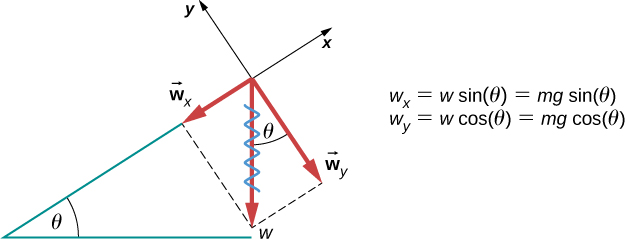| << Chapter < Page | Chapter >> Page > |
Substituting this into Newton’s second law, gives
We substitute known values to obtain
This gives us
which is the acceleration parallel to the incline when there is 45.0 N of opposing friction.
When an object rests on an incline that makes an angle with the horizontal, the force of gravity acting on the object is divided into two components: a force acting perpendicular to the plane, , and a force acting parallel to the plane, ( [link] ). The normal force is typically equal in magnitude and opposite in direction to the perpendicular component of the weight . The force acting parallel to the plane, , causes the object to accelerate down the incline.

Be careful when resolving the weight of the object into components. If the incline is at an angle to the horizontal, then the magnitudes of the weight components are
and
We use the second equation to write the normal force experienced by an object resting on an inclined plane:
Instead of memorizing these equations, it is helpful to be able to determine them from reason. To do this, we draw the right angle formed by the three weight vectors. The angle of the incline is the same as the angle formed between w and . Knowing this property, we can use trigonometry to determine the magnitude of the weight components:
Check Your Understanding A force of 1150 N acts parallel to a ramp to push a 250-kg gun safe into a moving van. The ramp is frictionless and inclined at (a) What is the acceleration of the safe up the ramp? (b) If we consider friction in this problem, with a friction force of 120 N, what is the acceleration of the safe?
a. b.
A tension is a force along the length of a medium; in particular, it is a pulling force that acts along a stretched flexible connector, such as a rope or cable. The word “tension” comes from a Latin word meaning “to stretch.” Not coincidentally, the flexible cords that carry muscle forces to other parts of the body are called tendons .
Any flexible connector, such as a string, rope, chain, wire, or cable, can only exert a pull parallel to its length; thus, a force carried by a flexible connector is a tension with a direction parallel to the connector. Tension is a pull in a connector. Consider the phrase: “You can’t push a rope.” Instead, tension force pulls outward along the two ends of a rope.

Notification Switch
Would you like to follow the 'University physics volume 1' conversation and receive update notifications?